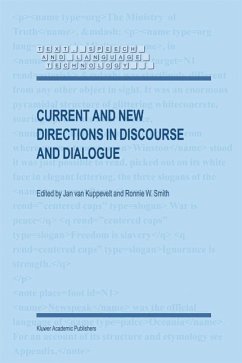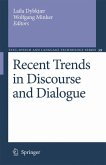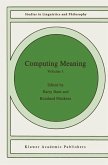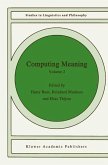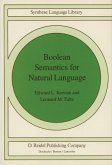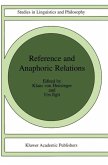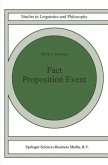Current and New Directions in Discourse and Dialogue (eBook, PDF)
Redaktion: Kuppevelt, Jan C. J. van; Smith, R. W.
113,95 €
113,95 €
inkl. MwSt.
Sofort per Download lieferbar

57 °P sammeln
113,95 €
Als Download kaufen

113,95 €
inkl. MwSt.
Sofort per Download lieferbar

57 °P sammeln
Jetzt verschenken
Alle Infos zum eBook verschenken
113,95 €
inkl. MwSt.
Sofort per Download lieferbar
Alle Infos zum eBook verschenken

57 °P sammeln
Current and New Directions in Discourse and Dialogue (eBook, PDF)
Redaktion: Kuppevelt, Jan C. J. van; Smith, R. W.
- Format: PDF
- Merkliste
- Auf die Merkliste
- Bewerten Bewerten
- Teilen
- Produkt teilen
- Produkterinnerung
- Produkterinnerung

Bitte loggen Sie sich zunächst in Ihr Kundenkonto ein oder registrieren Sie sich bei
bücher.de, um das eBook-Abo tolino select nutzen zu können.
Hier können Sie sich einloggen
Hier können Sie sich einloggen
Sie sind bereits eingeloggt. Klicken Sie auf 2. tolino select Abo, um fortzufahren.

Bitte loggen Sie sich zunächst in Ihr Kundenkonto ein oder registrieren Sie sich bei bücher.de, um das eBook-Abo tolino select nutzen zu können.
This volume covers key topics in the field from a variety of leading researchers. In one volume, readers gain exposure to several perspectives in the areas of corpus annotation and analysis, dialogue system construction, theoretical perspectives on communicative intention, context-based generation, and modeling of discourse structure. Based on the 2nd SIGdial workshop on Discourse and Dialogue held in conjunction with Eurospeech 2001, it is of interest to researchers and practitioners in dialogue and discourse processing.
- Geräte: PC
- ohne Kopierschutz
- eBook Hilfe
- Größe: 35.5MB
Andere Kunden interessierten sich auch für
![Recent Trends in Discourse and Dialogue (eBook, PDF) Recent Trends in Discourse and Dialogue (eBook, PDF)]() Recent Trends in Discourse and Dialogue (eBook, PDF)113,95 €
Recent Trends in Discourse and Dialogue (eBook, PDF)113,95 €![Computing Meaning (eBook, PDF) Computing Meaning (eBook, PDF)]() Computing Meaning (eBook, PDF)113,95 €
Computing Meaning (eBook, PDF)113,95 €![Computing Meaning (eBook, PDF) Computing Meaning (eBook, PDF)]() Computing Meaning (eBook, PDF)113,95 €
Computing Meaning (eBook, PDF)113,95 €![Boolean Semantics for Natural Language (eBook, PDF) Boolean Semantics for Natural Language (eBook, PDF)]() Edward L. KeenanBoolean Semantics for Natural Language (eBook, PDF)113,95 €
Edward L. KeenanBoolean Semantics for Natural Language (eBook, PDF)113,95 €![Reference and Anaphoric Relations (eBook, PDF) Reference and Anaphoric Relations (eBook, PDF)]() Reference and Anaphoric Relations (eBook, PDF)40,95 €
Reference and Anaphoric Relations (eBook, PDF)40,95 €![Properties, Types and Meaning (eBook, PDF) Properties, Types and Meaning (eBook, PDF)]() Properties, Types and Meaning (eBook, PDF)113,95 €
Properties, Types and Meaning (eBook, PDF)113,95 €![Fact Proposition Event (eBook, PDF) Fact Proposition Event (eBook, PDF)]() P. L. PetersonFact Proposition Event (eBook, PDF)113,95 €
P. L. PetersonFact Proposition Event (eBook, PDF)113,95 €-
-
-
This volume covers key topics in the field from a variety of leading researchers. In one volume, readers gain exposure to several perspectives in the areas of corpus annotation and analysis, dialogue system construction, theoretical perspectives on communicative intention, context-based generation, and modeling of discourse structure. Based on the 2nd SIGdial workshop on Discourse and Dialogue held in conjunction with Eurospeech 2001, it is of interest to researchers and practitioners in dialogue and discourse processing.
Hinweis: Dieser Artikel kann nur an eine deutsche Lieferadresse ausgeliefert werden.
Dieser Download kann aus rechtlichen Gründen nur mit Rechnungsadresse in A, B, BG, CY, CZ, D, DK, EW, E, FIN, F, GR, HR, H, IRL, I, LT, L, LR, M, NL, PL, P, R, S, SLO, SK ausgeliefert werden.
Hinweis: Dieser Artikel kann nur an eine deutsche Lieferadresse ausgeliefert werden.
Produktdetails
- Produktdetails
- Verlag: Springer Netherlands
- Seitenzahl: 381
- Erscheinungstermin: 6. Dezember 2012
- Englisch
- ISBN-13: 9789401000192
- Artikelnr.: 43983761
- Verlag: Springer Netherlands
- Seitenzahl: 381
- Erscheinungstermin: 6. Dezember 2012
- Englisch
- ISBN-13: 9789401000192
- Artikelnr.: 43983761
- Herstellerkennzeichnung Die Herstellerinformationen sind derzeit nicht verfügbar.
1 Annotations and Tools for an Activity Based Spoken Language Corpus.- 1. Introduction.- 2. GSLC and Other Goteborg Corpora.- 3. Storage.- 4. Description of the Corpus Transcription Standard.- 5. Tools Which Have Been Developed.- 6. Types of Quantitative Analysis.- 7. Types of Qualitative Analysis.- 8. Conclusions and Future Directions.- References.- 2 Using Direct Variant Transduction for Rapid Development of Natural Spoken Interfaces.- 1. Introduction.- 2. Characteristics of Direct Variant Transduction.- 3. Constructing an Application with Example-Action Contexts.- 4. Context Expansion.- 5. Recognition, Classification and Matching.- 6. Dialog Control and Confirmation.- 7. Experiments.- 8. Concluding Remarks.- References.- 3 An Interface for Annotating Natural Interactivity.- 1. Introduction.- 2. Today's Natural Interactivity Coding Tools.- 3. The Nite Project.- 4. Nite Target User Groups.- 5. General Tool Requirements.- 6. Annotation User Interface Requirements.- 7. The Audio-Visual Annotation Interface.- 8. Conclusion and Future Work.- Acknowledgements.- References.- 4 Managing Communicative Intentions with Collaborative Problem Solving.- 1. Previous Work.- 2. A Collaborative Problem-Solving Model.- 3. Examples.- 4. Use in Dialogue Systems.- 5. Conclusions and Future Work.- References.- 5 Building a Discourse-Tagged Corpus in the Framework of Rhetorical Structure Theory.- 1. Introduction.- 2. Framework.- 3. Discourse Annotation Task.- 4. Quality Assurance.- 5. Corpus Overview.- 6. Mining the RST Corpus.- 7. Conclusions and Future Work.- Acknowledgements.- References.- 6 An Empirical Study of Speech Recognition Errors in Human Computer Dialogue.- 1. Introduction.- 2. The Speech Recognition Component.- 3. Integrated Parsing of User Utterances.- 4. The DialogueProcess.- 5. From Speech Recognition Errors to Speech Act Recognition Errors.- 6. Evaluating Robustness to Speech Recognition Errors.- 7. Conclusion.- Acknowledgements.- References.- 7 Comparing Several Aspects of Human-Computer and Human-Human Dialogues.- 1. Introduction.- 2. Our Data.- 3. Analysis.- 4. Analysis of Misunderstandings.- 5. Discussion.- 6. Conclusions.- Appendix: Dialogue Act Tag Set and Examples.- References.- 8 Full Paraphrase Generation for Fragments in Dialogue.- 1. Introduction.- 2. SHARDS.- 3. Generation of Fragment Paraphrases.- 4. An Implemented System for Fragment Resolution and Paraphrase Generation.- 5. Conclusion and Future Research.- Acknowledgements.- References.- 9 Disentangling Public from non-Public Meaning.- 1. Introduction.- 2. Utterer's Content v. Utterer's Plan.- 3. Clarifying Utterer's Content.- 4. Whymeta: an analysis.- 5. Concluding Remarks.- References.- 10 Adaptivity and Response Generation in a Spoken Dialogue System.- 1. Introduction.- 2. Interaction Management.- 3. Dialogue Response Generation.- 4. Confidence-based Adaptivity.- 5. Conclusion.- References.- 11 On the Means for Clarification in Dialogue.- 1. Introduction.- 2. Clarification Forms.- 3. Clarification Readings.- 4. Corpus Analysis.- 5. Conclusions.- Acknowledgements.- Appendix: Corpus Markup Decision Trees.- References.- 12 Plug and Play Spoken Dialogue Processing.- 1. Introduction.- 2. The CANTONA Plug and Play Demonstrator.- 3. Device Descriptions: Rules and Hierarchies.- 4. Plug and Play Response Generation.- 5. Plug and Play Speech Recognition and Parsing.- 6. Discussion.- Acknowledgements.- References.- 13 Conversational Implicatures and Communication Theory.- 1. Introduction.- 2. Particularized Conversational Implicatures.- 3. Generalized ConversationalImplicatures.- References.- 14 Reconciling Control and Discourse Structure.- 1. Introduction.- 2. Discourse Structure and Control Analysis.- 3. Relationship between Control and Discourse Structure.- 4. Reconciling Control inside Discourse Segments.- 5. Conclusion.- 6. Future Work.- Acknowledgements.- References.- 15 The Information State Approach to Dialogue Management.- 1. Introduction.- 2. The Information State Approach.- 3. A Multi-level Architecture for Reusable Dialogue Management.- 4. TrindiKit: A Dialogue Move Engine Toolkit.- 5. Implementations using TrindiKit.- 6. Reusing Dialogue Management Components.- References.- 16 Visualizing Spoken Discourse.- 1. Introduction: Interruptions and Dialogue.- 2. Research Goals and Procedures.- 3. Prosodie Characteristics of Interruptions.- 4. Implications for Dialogue Systems.- 5. Conclusion.- Acknowledgements.- References.
1 Annotations and Tools for an Activity Based Spoken Language Corpus.- 1. Introduction.- 2. GSLC and Other Goteborg Corpora.- 3. Storage.- 4. Description of the Corpus Transcription Standard.- 5. Tools Which Have Been Developed.- 6. Types of Quantitative Analysis.- 7. Types of Qualitative Analysis.- 8. Conclusions and Future Directions.- References.- 2 Using Direct Variant Transduction for Rapid Development of Natural Spoken Interfaces.- 1. Introduction.- 2. Characteristics of Direct Variant Transduction.- 3. Constructing an Application with Example-Action Contexts.- 4. Context Expansion.- 5. Recognition, Classification and Matching.- 6. Dialog Control and Confirmation.- 7. Experiments.- 8. Concluding Remarks.- References.- 3 An Interface for Annotating Natural Interactivity.- 1. Introduction.- 2. Today's Natural Interactivity Coding Tools.- 3. The Nite Project.- 4. Nite Target User Groups.- 5. General Tool Requirements.- 6. Annotation User Interface Requirements.- 7. The Audio-Visual Annotation Interface.- 8. Conclusion and Future Work.- Acknowledgements.- References.- 4 Managing Communicative Intentions with Collaborative Problem Solving.- 1. Previous Work.- 2. A Collaborative Problem-Solving Model.- 3. Examples.- 4. Use in Dialogue Systems.- 5. Conclusions and Future Work.- References.- 5 Building a Discourse-Tagged Corpus in the Framework of Rhetorical Structure Theory.- 1. Introduction.- 2. Framework.- 3. Discourse Annotation Task.- 4. Quality Assurance.- 5. Corpus Overview.- 6. Mining the RST Corpus.- 7. Conclusions and Future Work.- Acknowledgements.- References.- 6 An Empirical Study of Speech Recognition Errors in Human Computer Dialogue.- 1. Introduction.- 2. The Speech Recognition Component.- 3. Integrated Parsing of User Utterances.- 4. The DialogueProcess.- 5. From Speech Recognition Errors to Speech Act Recognition Errors.- 6. Evaluating Robustness to Speech Recognition Errors.- 7. Conclusion.- Acknowledgements.- References.- 7 Comparing Several Aspects of Human-Computer and Human-Human Dialogues.- 1. Introduction.- 2. Our Data.- 3. Analysis.- 4. Analysis of Misunderstandings.- 5. Discussion.- 6. Conclusions.- Appendix: Dialogue Act Tag Set and Examples.- References.- 8 Full Paraphrase Generation for Fragments in Dialogue.- 1. Introduction.- 2. SHARDS.- 3. Generation of Fragment Paraphrases.- 4. An Implemented System for Fragment Resolution and Paraphrase Generation.- 5. Conclusion and Future Research.- Acknowledgements.- References.- 9 Disentangling Public from non-Public Meaning.- 1. Introduction.- 2. Utterer's Content v. Utterer's Plan.- 3. Clarifying Utterer's Content.- 4. Whymeta: an analysis.- 5. Concluding Remarks.- References.- 10 Adaptivity and Response Generation in a Spoken Dialogue System.- 1. Introduction.- 2. Interaction Management.- 3. Dialogue Response Generation.- 4. Confidence-based Adaptivity.- 5. Conclusion.- References.- 11 On the Means for Clarification in Dialogue.- 1. Introduction.- 2. Clarification Forms.- 3. Clarification Readings.- 4. Corpus Analysis.- 5. Conclusions.- Acknowledgements.- Appendix: Corpus Markup Decision Trees.- References.- 12 Plug and Play Spoken Dialogue Processing.- 1. Introduction.- 2. The CANTONA Plug and Play Demonstrator.- 3. Device Descriptions: Rules and Hierarchies.- 4. Plug and Play Response Generation.- 5. Plug and Play Speech Recognition and Parsing.- 6. Discussion.- Acknowledgements.- References.- 13 Conversational Implicatures and Communication Theory.- 1. Introduction.- 2. Particularized Conversational Implicatures.- 3. Generalized ConversationalImplicatures.- References.- 14 Reconciling Control and Discourse Structure.- 1. Introduction.- 2. Discourse Structure and Control Analysis.- 3. Relationship between Control and Discourse Structure.- 4. Reconciling Control inside Discourse Segments.- 5. Conclusion.- 6. Future Work.- Acknowledgements.- References.- 15 The Information State Approach to Dialogue Management.- 1. Introduction.- 2. The Information State Approach.- 3. A Multi-level Architecture for Reusable Dialogue Management.- 4. TrindiKit: A Dialogue Move Engine Toolkit.- 5. Implementations using TrindiKit.- 6. Reusing Dialogue Management Components.- References.- 16 Visualizing Spoken Discourse.- 1. Introduction: Interruptions and Dialogue.- 2. Research Goals and Procedures.- 3. Prosodie Characteristics of Interruptions.- 4. Implications for Dialogue Systems.- 5. Conclusion.- Acknowledgements.- References.
